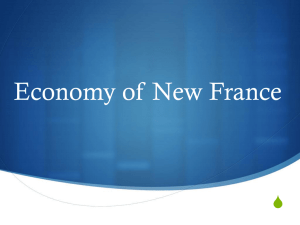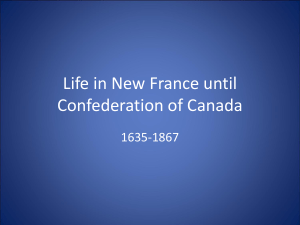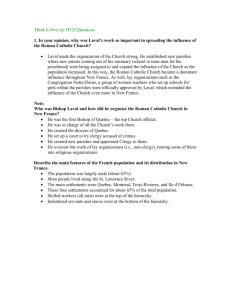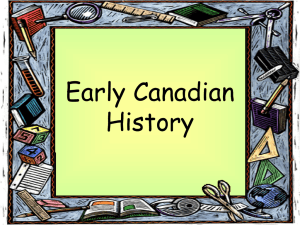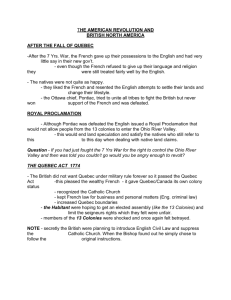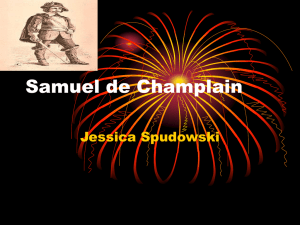French Colonialism and English Colonialism
advertisement
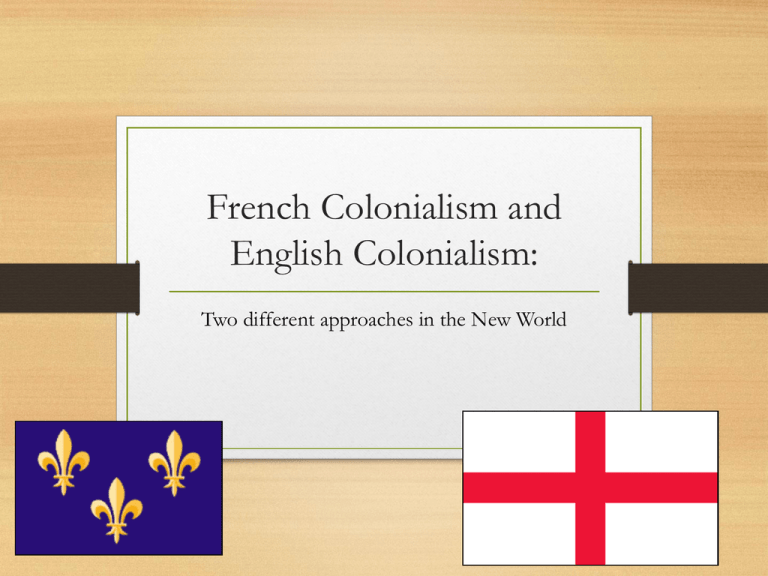
French Colonialism and
English Colonialism:
Two different approaches in the New World
Portuguese/Spanish Colonies-earlier
than Brits and French
French Colonies: Acadia (N.S.), Quebec,
Louisiana, Louisburg
English Colonies:
Newfoundland, Boston, New York, Pennsylvania,
Virginia, {Halifax/Nova Scotia (100 years later) }
Colonialism- rich “mother countries” setting up
colonies in distant lands to profit from resources
found in those lands (e.g. fur)
• Imperialism- Empire building by rich
countries through colonialism.
Largest western Ancient Empire was
Rome (or Alexander the Great’s
Macedonia).
Largest Eastern empire was Genghis
Khan’s Mongolian Empire.
The Largest Modern empire was the
British Empire (U.S.?)
Champlain- “Father of New
France”/Empire builder
Why Did it Take 70 years after Cartier for France to
start New World Colonies?
• As the protestant Huguenots gained influence and
displayed their faith more openly, Roman Catholic
hostility to them grew, even though the French crown
offered increasingly liberal political concessions and
edicts of toleration.
• In 1561, the Edict of Orléans declared an end to the
persecution, and the Edict of Saint-Germain of January
1562 formally recognized the Huguenots for the first
time.
• However, these measures disguised the growing
tensions between Protestants and Catholics.
Civil Wars
• These tensions spurred eight civil wars,
interrupted by periods of relative calm, between
1562 and 1598.
• With each break in peace, the Huguenots' trust in
the Catholic throne diminished, and the violence
became more severe, and Protestant demands
became grander, until a lasting cessation of open
hostility finally occurred in 1598.
• With wars ended, more emphasis could be placed
on colonies abroad…enter Champlain!
Champlain and New France
• In 1603, Samuel de Champlain and his crew, following Jacques
Cartier’s lead of 70 years before, sailed from France.
• They sailed up the St. Lawrence River and most of Quebec. He
returned to France in 1603, and decided to search for a
Northwest Passage and to settle the Gaspe Peninsula of Quebec.
•He returned to Canada in 1604 on
Sieur de Mont's expedition (de Mont
was the true founder of Port Royal).
•From 1604-1607, he sailed around
and charted most of the coast of
Nova Scotia and New England
Now we know where
SNOOP gets his style!
1604
• Samuel de Champlain and his crew attempted a settlement at Ste.
Croix Island (now part of Maine)
• It was a horrible failure due to extremely cold weather and the
horrible disease scurvy (lack of vitamin c causes it).
• YouTube - Canada Vignettes - Port Royal
Scurvy: why you should
eat fruit!
1605
• Champlain and Sieur de Monts and the survivors cross the Bay
of Fundy to Port Royal (now in Nova Scotia) and it is here that
the first French permanent settlement was established. Fur Trade
relations with the Mi’kmaq were good. Chief Membertou
converted to Catholicism.
• The fur trading Habitation became the home of the first social
club in the New World (The Order of Good Cheer) set up to
make the tedious days go by.
• The first play, the “Theatre de Neptune” is also written by Marc
Lescarbot.
• He also documents life among the Mi’kmaq in an early history
book. Relations with Mi’kmaq here are good and a fur trade is
established.
Matthieu da Costa was at Port Royal
1st Black person in the New World? Translator of
Mi’kmaq
Engraving after a 1609 drawing by
Champlain of an Indian battle near
Ticonderoga , NY
1608-1635
• In 1608, Champlain left Port Royal and led 32 colonists to settle
Quebec in order to establish it as a fur-trading center.
• Only nine colonists survived the first bitter winter in Quebec,
but more settlers arrived the following summer.
• In 1609, Champlain befriended the Huron Indians and helped
them fight the Iroquois (this battle led to 150 years of bitterness
and hostility between the Iroquois and the French).
• It was during this venture that he discovered the very large
Lake Champlain (in upstate New York)
• In 1613, he again sailed up the St. Lawrence,
and explored the Ottawa River.
•Two years later, in 1615 ,after returning from
France, he retraced this route and ventured into
what is now northern New York state and the
eastern Great Lakes (Georgian Bay of Lake
Huron, and Lake Ontario).
• Champlain headed the Quebec settlement for
years, until the English attacked and took the
Fort at Quebec in July, 1629.
• After a French-British peace treaty in 1632,
Quebec was once again French, and Champlain
returned as its governor (1633).
•He died from a stroke there on Dec. 25, 1635.
New France’s Main Purpose?
• ECONOMICS! The fur trade was set up so that
few Frenchmen would have to come over to keep
the profits high and the “overhead” low.
• Native trappers would trade furs for European
goods to this “skeleton crew.”
• It was only when the colony was threatened that
King Louis XIV sent over military to protect from
English/Native threats and Les Filles de Roi
(King’s Girls) to marry the males and grow the
colony with babies!
• The original “pure laine” Quebecois (pure wool)
•
•
•
•
VOYAGEURS
Fur trade
Seigneurial System
Hudson Bay Company
Other Hudson Bay Company
• YouTube - Hinterland Who's Who - Beaver
The Staple Thesis mirrors modern
Canada somewhat
• Canada’s Development was due to its economic
nature:
• Atlantic Canada-Fishing (cooperative nature)
• Ontario/Quebec-Fur-HBC/NWC
(Businesslike)
• Prairies-Farming (Solitary, frontier-mentality)
• B.C.-Forestry (Tree Huggers?)
A sideline: Religion
• The Jesuit priests (“Black Robes”) came over to
convert the Native peoples to Catholicism. They
felt that otherwise the poor “savages” were
doomed to Hell!
New England and the
Puritans/Pilgrims
Provincetown-ironic location
The Plymouth Colony
(near Boston),
Massachussetts
1620-The Mayflower from
Plymouth, England arrives at
Plymouth Rock near Cape Cod
It brought the Pilgrims, a group of Puritans
who were seeking freedom from oppression
at home.
They wanted to be able to practise their
“pure” form of Christianity away from what
they considered the evils of England.
They wanted to start a “New England!”
The Mayflower Compact gave more rights
and freedoms (to MEN) than they would
have in England.
Their faith was very strict and moral:
dancing, acting, singing in Church were all
shunned. This is where we get the
description “puritanical” to described very
moral people. They also held the Salem witch
trials to punish evil!
The First U.S. Thanksgiving
• The Mayflower anchored off the tip of Cape Cod on
November 11, 1620 and stayed in America that winter. Its
crew suffered the effects of the first winter just as the
Pilgrims did, with almost half dying. Some think the First
Thanksgiving was in November 1621 to thank God and the
local Wampanoag people for their help in surviving.
The MAIN REASON for New
England/America’s beginning?
• Religious FREEDOM.
• It could be argued that this began with the Puritans at Plymouth,
Mass. in 1620!
• “LIFE, LIBERTY AND THE PURSUIT OF HAPPINESS”
“FREEDOM!” “In God We Trust!” These are all American
sayings.
New France/Canada?
• It was all about making money off of the raw materials of cold,
forested land of the North.
• It can be argued that Canada was born out of the
economic use of its staple resources: fur, timber,
wheat and fish.(“THE 4 F’s”)
• America also saw all of these industries too (plus,
of course the cotton plantations of the south and,
horribly, slavery!!!)but Freedom seems to be a
reoccurring theme in U.S history (for some).
Canada? Think furs, the Hudson Bay Company
and $$$!
• This is ironic, considering one of the most
capitalistic nations on Earth is America.
• However, it is also said to be the most religious
nation in the West.
• Is America an anomaly? A Christian nation full of
extremely decadent wealth, sin and exploitation?
• What is the nature of Canada? Make a list
• http://www.youtube.com/watch?v=fy1IOIlpKaw
• YouTube - The Puritan Experience: Making of a
New World (clip)
Colonialism and wars!
YouTube - American Colonies

